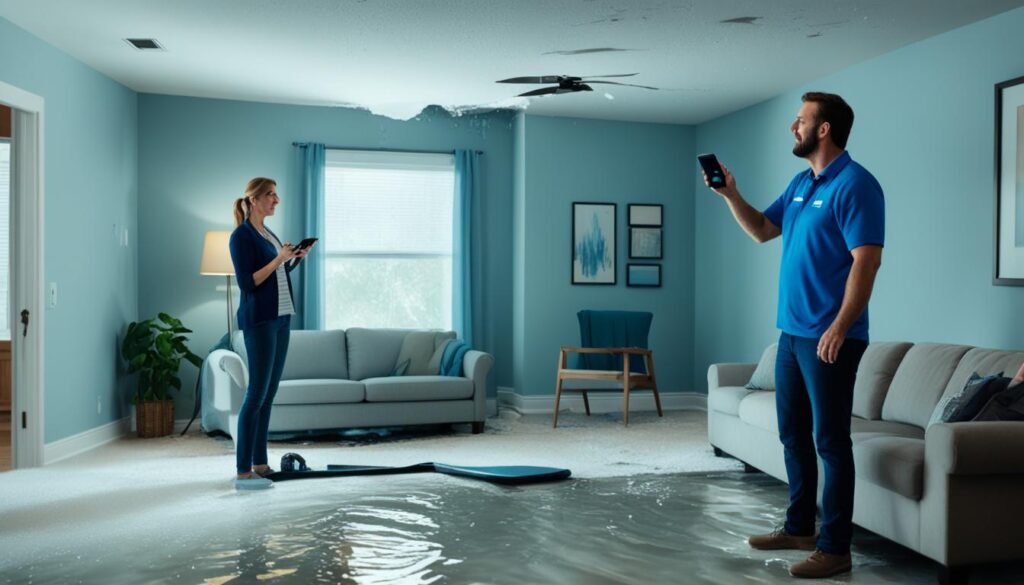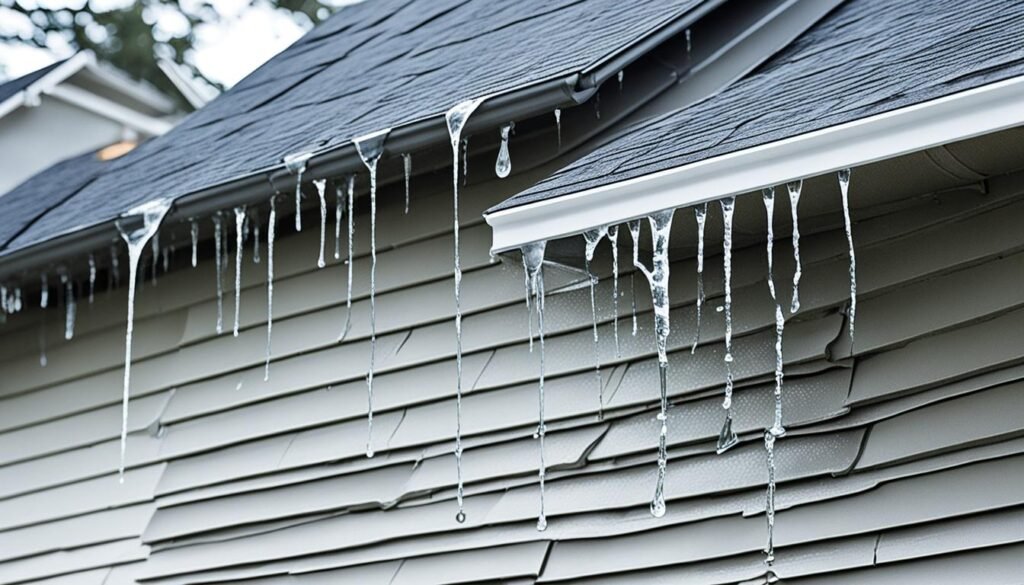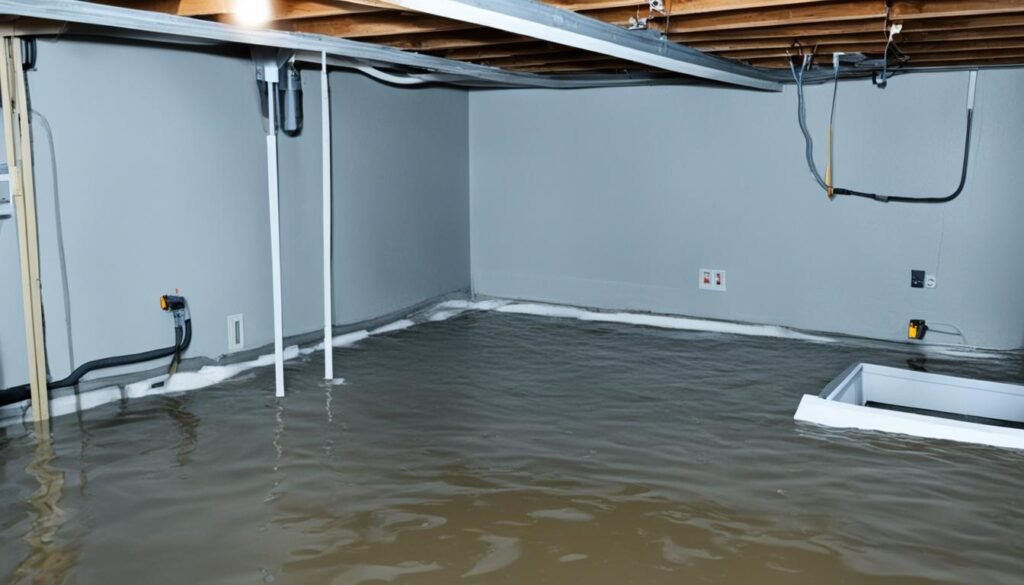Did you know that water damage costs over $13 billion in claims each year for U.S. homeowners? Not all water damage is covered by standard homeowners insurance. It’s important to know what your policy covers and what it doesn’t when dealing with water damage claims.
Key Takeaways
- Homeowners insurance usually covers sudden or accidental water damage from inside the home, like burst pipes or appliance overflows.
- Maintenance issues, the cause of the water damage, and flood-related damage are not covered by standard homeowners policies.
- You need separate flood insurance to protect against damage from natural floods.
- Knowing what your policy covers helps you make successful water damage claims.
- Preventing damage and acting quickly when it happens is crucial to reduce losses and get the most from your insurance.
Understanding Covered and Non-Covered Water Damage
Homeowners insurance helps protect you from unexpected and accidental damages, including some water damage types. It’s key to know what your policy covers and what it doesn’t. This knowledge helps you make smart choices about your coverage and keeps you safe.
Covered Water Damage
Your insurance usually covers sudden and accidental water damage, like:
- Burst pipes or plumbing leaks
- Overflowing appliances, like washing machines or dishwashers
- Storm-related roof leaks or other water intrusion from severe weather
Your policy will likely pay for fixing the damaged areas. But, it might not cover the cost of replacing the pipe, appliance, or the source of the water damage.
Non-Covered Water Damage
Some water damage isn’t covered by standard homeowners insurance, such as:
- Flooding from external sources, like rivers, lakes, or storm surges
- Sewer or drain backups
- Groundwater seepage or moisture intrusion
- Mold remediation, unless it’s from a covered water damage event
To guard against these issues, you might need extra coverage. This could be a separate flood insurance policy or an endorsement for water backup and sump pump coverage.
“Understanding the scope of your homeowners insurance coverage is crucial when it comes to water damage. Knowing what is and isn’t covered can help you make informed decisions about your protection and potential mitigation needs.”
What water damage is covered in homeowners insurance
Homeowners insurance usually covers various water-related damages inside your home. This includes burst pipes, overflowing appliances, and storm-related roof leaks. Your policy can help with sudden and accidental water problems. But, not all water damage is covered, so it’s key to know what your policy says.
Water leaks and burst pipes are often covered. If a plumbing problem causes water damage, your insurance will likely pay for repairs. This covers fixing drywall, flooring, or other parts damaged by the leak.
Appliance overflows, like a washing machine or dishwasher, are also covered. If these appliances fail and cause water damage, you can get help from your insurance. But, fixing or replacing the broken appliance might not be covered.
Roof leaks from storms or other sudden weather events are another covered type of damage. This is great if heavy rain, strong winds, or a fallen tree damage your roof and let water in.
| Type of Water Damage | Covered by Homeowners Insurance? |
|---|---|
| Burst Pipes | Yes |
| Appliance Overflows | Yes |
| Roof Leaks (Storm-Related) | Yes |
| Gradual Leaks | No |
| Flooding (External) | No |
| Sewer Backups | No |
But, not all water-related damages are covered by homeowners insurance. Gradual leaks, external flooding, and sewer backups are usually not covered. For these, you might need extra coverage or riders on your policy.

Knowing what your homeowners insurance covers for water damage helps you protect your home and money. Review your policy and talk to your insurance company to make sure you have the right coverage. This way, you’re ready for plumbing problems or weather events.
Preventive Measures and Claims Process
To keep your home safe from water damage, it’s key to act early. Check and maintain your appliances, water heaters, and plumbing often. This helps spot and fix problems before they get worse. Using leak sensors and winterizing pipes can also help prevent sudden water issues.
Preventing Water Damage
Being proactive is a great way to dodge the trouble and costs of water damage. Make sure your home’s appliances, plumbing, and water heater work well. Swap out old hoses and pipes, and think about getting water-leak detection systems to warn you of issues.
- Inspect appliance hoses and replace them every 3-5 years
- Check the water heater for signs of corrosion or leaks
- Insulate exposed pipes to prevent freezing and bursting during the winter
- Install water-leak detection devices to catch problems early
Filing a Water Damage Claim
If your home suffers water damage, act fast to lessen the damage. First, stop the water flow, remove standing water, and dry out the area. This helps prevent more damage and mold. Then, file a claim with your homeowners insurance company.
When you file a claim, be ready to give details about the damage and any evidence you have, like photos or videos. The claims process usually means an adjuster will check the damage and figure out what repairs are covered. Know your policy’s deductible and what’s not covered by water damage insurance.
| Preventive Measure | Benefit |
|---|---|
| Regularly inspect appliance hoses | Identify and replace aging hoses before they fail |
| Check water heater for signs of corrosion | Prevent sudden leaks and water damage |
| Insulate exposed pipes | Avoid freezing and bursting pipes during winter |
| Install water-leak detection devices | Catch problems early and minimize damage |
By preventing water damage and knowing how to file a claim, you can keep your home safe. FloodFixers are ready to help you with water damage issues and make sure your home is fixed quickly and right.

Conclusion
Homeowners insurance is key to protecting your home and money from sudden water damage. It covers some types of water incidents but has limits and exclusions. Knowing what’s covered helps you prevent problems and be ready for emergencies.
If you face a burst pipe, a broken appliance, or flooding from a storm, understanding the claims process is vital. Resources like FloodFixers can guide you through. Reviewing your policy and taking steps to prevent damage keeps your home and finances safe.
It’s important for every homeowner to grasp the details of insurance coverage for water damage. Being informed and proactive keeps your home and family safe, no matter what happens.


